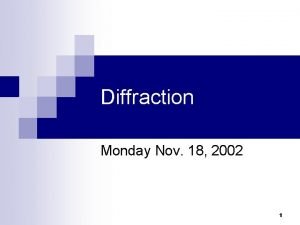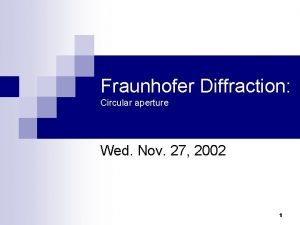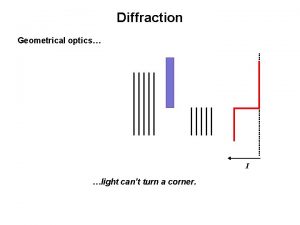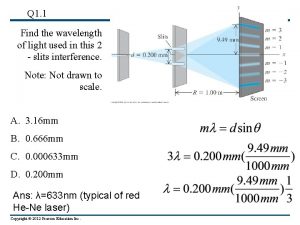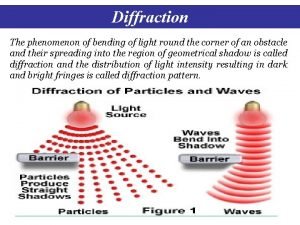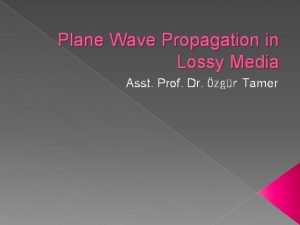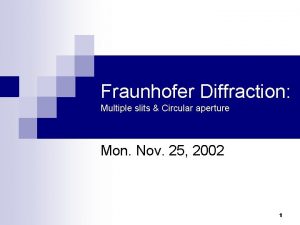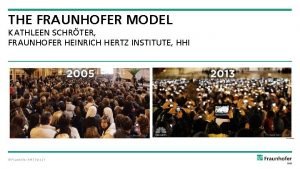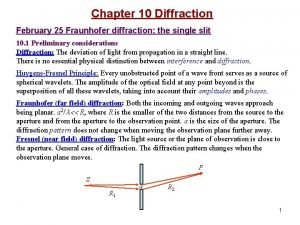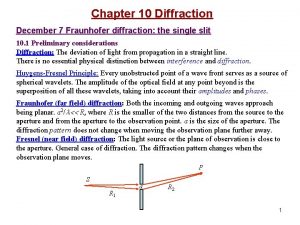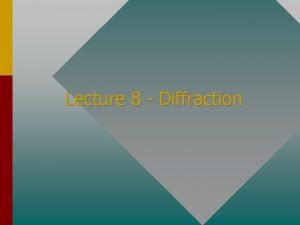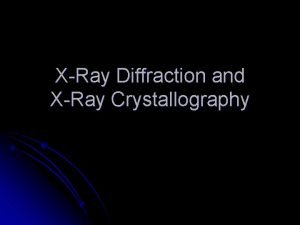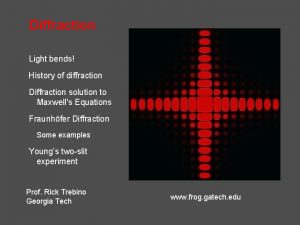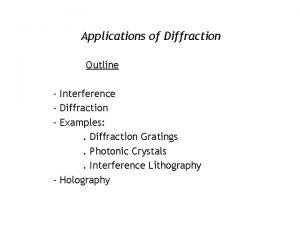Lecture 10 D Aims Wave propagation Fraunhofer diffraction









- Slides: 9

Lecture 10 D Aims: Wave propagation. ë Fraunhofer diffraction (waves in the “far field”). >Young’s double slits >Three slits >N slits and diffraction gratings >A single broad slit >General formula - Fourier transform. 1 Waves 10

Fraunhofer diffraction D Diffraction. ë Propagation of partly obstructed waves. >Apertures, obstructions etc. . . D Diffraction régimes. ë In the immediate vicinity of the obstruction: >Large angles and no approximations >Full solution required. ë Intermediate distances (near field) >Small angles, spherical waves, >Fresnel diffraction. ë Large distances (far field) >Small angles, and plane waves, >Fraunhofer diffraction. ë (More formal definitions will come in the Optics course) 2 Waves 10

Young’s slits D Fraunhofer conditions ë For us this means an incident plane wave and observation at infinity. D Two narrow apertures (2 point sources) ë Each slit is a source of secondary wavelets ë Full derivation (not in handout) is…. Applying “cos rule” to top triangle gives 3 Waves 10

2 -slit diffraction ë Similarly for bottom ray ë Resultant is a superposition of 2 wavelets ë The term expi(k. R-wt) will occur in all expressions. We ignore it - only relative phases are important. Where s = sinq. 4 Waves 10

cos-squared fringes ë We observe intensity cos-squared fringes. Spacing of maxima ë Spacing inversely proportional to separation of the slits. D Amplitude-phase diagrams. Resultant Slit 1 Slit 2 5 Waves 10

Three slits D Three slits, spacing d. ë Primary maxima separated by l/d, as before. ë One secondary maximum. 6 Waves 10

N slits and diffraction gratings D N slits, each separated by d. ë A geometric progression, which sums to Spacing, as before N-2, secondary maxima ë Intensity in primary maxima a N 2 ë In the limit as N goes to infinity, primary maxima become d-functions. A diffraction grating. 7 Waves 10

Single broad slit D Slit of width t. Incident plane wave. ë Summation of discrete sources becomes an integral. l/t 8 Waves 10

Generalisation to any aperture D Aperture function ë The amplitude distribution across an aperture can take any form a(y). This is the aperture function. ë The Fraunhofer diffraction pattern is ë putting ks=K gives a Fourier integral ë The Fraunhofer diffraction pattern is the Fourier Transform of the aperture function. ë Diffraction from complicated apertures can often be simplified using the convolution theorem. ë Example: 2 -slits of finite width Convolution of 2 d-functions with a single broad slit. FT(f*g) a FT(f). FT(g) Cos fringes sinc function 9 Waves 10
